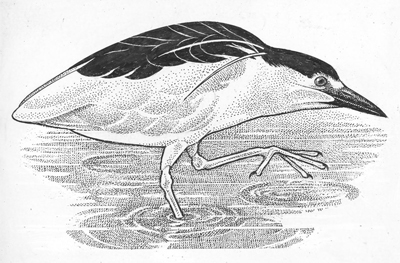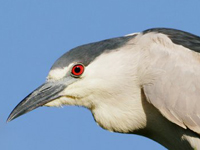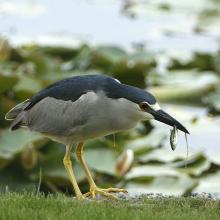

Join BirdNote tomorrow, November 30th!
Illustrator David Sibley and actor H. Jon Benjamin will face off in the bird illustration battle of the century during BirdNote's Year-end Celebration and Auction!
The enigmatic Black-crowned Night-Heron is an intriguing predator. During the day, this easily overlooked bird does nothing at all except stand perfectly still, while resting on a half-submerged log. Unlike its more active relative, the pterodactyl-like Great Blue, a giant among herons, it waits until dark to make its move.

The plumage of the bulky Black-crowned Night-Heron reminds me of a bouncer dressed in a tuxedo, accented by a punk accessory of several long white head feathers. But unlike the bouncers I’ve known or herons that skillfully spear their food (generally an unsuspecting fish or frog), the Black-crowned grabs its prey between its mandibles.
Its scientific name, acknowledging both genus and species, Nycticorax nycticorax, translates to “night raven,” in part because its call resembles the squawk of a true raven. I kept repeating the Latin name whenever I saw it, and the repetitive moniker piqued my curiosity. How many bird species, I wondered, have the same name for genus and species, like a biological Humbert Humbert from Nabokov’s Lolita? The answer is only 86 from the more than 10,000 bird species named by science.
What puts the Black-crowned Night-Heron on a truly elite list of only about six birds is its near worldwide distribution. The others are the Barn Owl, Peregrine Falcon, Mallard, Osprey, and Great Egret. This odd grouping of species can be found in almost every country. Biologists have yet to resolve this riddle of range size in birds. Perhaps the Black-crowned Night-Heron specializes on stalking in habitats — shallow ponds and marshes, freshwater, saltwater, or brackish — that are widespread, so it can find a place to hunt almost anywhere.
When I lived on the other side of the globe in Nepal’s lowland jungles, I used to have a colony of Black-crowned Night-Herons as neighbors; they lived in a dense sward of elephant grass bordering a large oxbow lake. During the day, the lake was filled with wallowing rhinoceroses, and on the edge, a kind of crocodile called the "mugger" would bask in the sun. How the Black-crowned Night-Herons foraged in the twilight with the muggers nearby always made me wonder for their safety.
If you're looking for a Black-crowned Night-Heron now, you might be disappointed. Around mid-September, they take off south. And where do they go? They may spend the winter in Florida or the Caribbean, or Mexico, or even Cuba. But look for them again early next Spring.
###
Check out this BirdNote show about the Black-crowned Night-Heron.
Adapted from an article that originally ran in The Village News.





